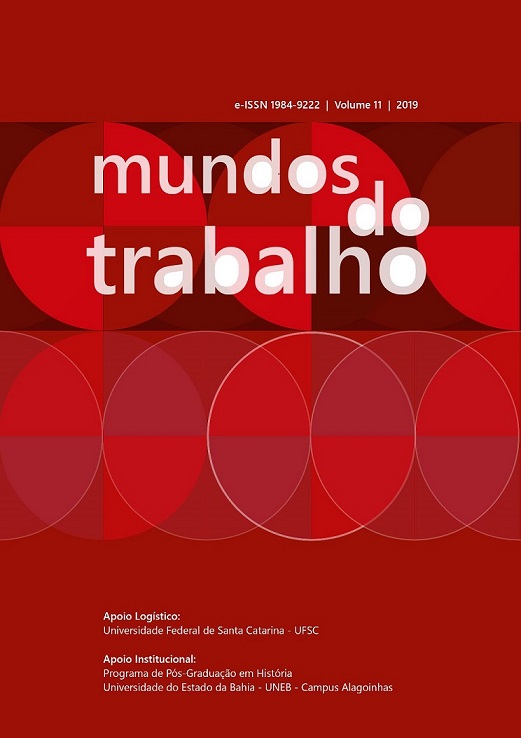The uses of film and visual sources in labour history
DOI:
https://doi.org/10.5007/1984-9222.2019.e69969Resumo
As soon as film technology was invented in the late nineteenth century, it was used by European film-makers to record, document and represent local working lives. The films were typically short, silent and monochrome. They were made and funded by different people for different purposes, including by business owners to promote their enterprises, as well as by showmen who charged those depicted to pay to come and see the spectacle of themselves and their friends on screen. The films were shown in a variety of settings, including traditional fairs and early cinemas. This article analyses a selection of films featuring a range of early twentieth century British workers compiled as part of a recent British TV history series to which I contributed – Edwardian Britain in Colour (Channel 5). The original films have been restored and colourised in order to bring them to life for a new audience. The article explores the complexities of capturing workers and workplaces on film and suggests how labour historians in Britain, Brazil and beyond can use films like these and other visual materials as valuable sources.
Referências
AMARAL, Marina; JONES, Dan. The Colour of Time: A New History of the World, 1850-1960. London: Head of Zeus Books, 2018.
ARENILLAS, María Guadalupe LAZZARA, Michael J. Latin American Documentary Film in the New Millennium, Springer, 2019.
ASSUNÇÃO, Matthias Röhrig et al. Jogo de Corpo (Body Games, Capoeira and Ancestry), 2014, https://www.capoeirahistory.com/angolan-roots/.
BERGER, Stefan; ALEXANDER, Peter (eds.). Making Sense of Mining History: Themes and Agendas. London: Routledge, 2019.
BINYON, Lawrence. The Fallen, 1914.
BRIDGEN, Cathy. Representations of labour: Images of work and workers in film, 22nd Association of Industrial Relations Academics in Australia and New Zealand (AIRAANZ) conference, 2008 [PDF available via Google Scholar].
CAMPBELL, Jonathan. In Pictures: New book turns historical black and white photos to colour. The Irish News, Belfast, 23 August 2018. https://www.irishnews.com/arts/2018/08/23/news/history-in-living-colour-1406603/
CONDE, Maite. Foundational Films: Early Cinema and Modernity in Brazil. Berkeley: University of California Press, 2018, p. 231.
COX, Pamela. Translating Labor History for Television. Revista Mundos do Trabalho, Florianópolis, v. 10, n. 19, p. 17-30, 2018.
COX, Pamela. História do Trabalho traduzida para a televisão. Revista Mundos do Trabalho, Florianópolis, v. 10, n. 19, p. 17-30, 2018.
COX, Pamela. Inaugural Professorial Lecture, Translating History for Television, University of Essex, December 2014, video available at: https://www.youtube.com/watch?v=8N92huO7b0I
DEGROOT, Gerard. Review: The Colour of Time: A New History of the World 1850-1960 by Dan Jones and Marina Amaral - the past in full colour. The Times, London, 4 August 2018, https://www.thetimes.co.uk/article/review-the-colour-of-time-anew-history-of-the-world-18501960-by-dan-jones-and-marina-amaral-the-past-comes-alive-xqwml8bxm
FRENCH, John D.; COWIE, Jefferson; LITTLEHALE, Scott. Labor and NAFTA: A Briefing Book. Miami: Center for Labor Research and Studies, Florida International University, 1994.
FURTADO, Gustavo Procopio. Documentary Filmmaking in Contemporary Brazil: Cinematic Archives of the Present. Oxford: Oxford University Press, 2018.
HERNÁNDEZ JR., Nicolás. "Quilombo" and "El Otro Francisco": A Post-Modernist Attempt to Re-Write Contemporary History and Colonial Slavery in Brazil and Cuba. Brazilian and Spanish American Literary and Cultural Encounters, v. 34, n 1, p. 97-112, 2005.
JONES, Stephen G. The British Labour Movement and Film, 1918-1939. London: Routledge, 2018 (first published, 1987).
LANZONI, Rémi Fournier. French Cinema: From Its Beginnings to the Present. New York; London: Bloomsbury Publishing, 2015.
NOVAES, Sylvia Caiuby; CUNHA, Edgar Teodoro da; HENLEY, Paul. The First Ethnographic Documentary? Luiz Thomaz Reis, the Rondon Commission and the Making of Rituais e Festas Borôro (1917). Visual Anthropology, v. 30, n. 2, p.105-146, 2017.
MAMIGONIAN, José Rafael G. and MAMIGONIAN, Beatriz. Em nome de Cruz e Sousa, 2020, distributed by Atalaia Filmes.
PARANAGUÁ, Paulo Antonio. Le Cinéma brésilien. Paris: Centre Georges Pompidou, 1987.
PETTINGER, Lynne. What’s Wrong with Work? Bristol: Policy Press and British Sociological Association, 2019.
PERRY, Matt Introduction: Visualizing Labour (special issue). Labour History Review, v. 84, n. 2, p.105-113, 2019.
SALGADO, Sebastião Workers: An Archaeology of the Industrial Age. London: Phaidon; 1993; and Trabalho, uma arqueologia da era industrial. Amadora (Portugal): Editorial Caminho, 1993.
SAMUEL, Raphael. Theatres of Memory: Past and Present in Contemporary Culture. London: Verso, 1994: p. 38.
STRANGLEMAN, Tim. Ways of (not) seeing work: The visual as a blindspot in WES. Work, Employment and Society, v. 18, n. 1, p. 179-192, 2004.
STRANGLEMAN, Tim. Representations of Labour: Visual Sociology and Work. Sociology Compass, v. 2, n. 5, p.1491-1505, 2008; and Picturing Work in an Industrial Landscape: Visualising Labour, Place and Space. Sociological Research Online, v. 17, n. 2, [no page numbers in online journal], 2012.
STRANGLEMAN, Tim Visual sociology and work organization: a historical approach. In: BELL, Emma; WARREN, Samantha; SCHROEDER, Jonathan E. (eds.). The Routledge Companion to Visual Organisation. London: Routledge, 2014, p. 243-258.
TOULMIN, Vanessa; POPPLE, Simon; RUSSELL, Patrick. The lost world of Mitchell and Kenyon: Edwardian Britain on film. London: British Film Institute Publications, 2004.
WATERMAN, Peter. The second coming of proletarian internationalism? A review of recent resources. European Journal of Industrial Relations, v. 4, n. 3, p. 349-377, 1998, p. 359.
WOLKOWITZ, Carol. Bodies at Work. London: Sage, 2006.
WOOD, Marcus. Black Milk: Imagining Slavery in the Visual Cultures of Brazil and America. Oxford: Oxford University Press, 2013.
ZANIELLO, Tom. Working Stiffs, Union Maids, Reds and Riffraff. Expanded edition. Ithaca: ILR Press; Cornell University Press, 2003.
Downloads
Publicado
Como Citar
Edição
Seção
Licença
Os autores cedem à Revista Mundos do Trabalho os direitos exclusivos de primeira publicação, com o trabalho simultaneamente licenciado sob a Licença Creative Commons Attribution (CC BY) 4.0 International. Esta licença permite que terceiros remixem, adaptem e criem a partir do trabalho publicado, atribuindo o devido crédito de autoria e publicação inicial neste periódico. Os autores têm autorização para assumir contratos adicionais separadamente, para distribuição não exclusiva da versão do trabalho publicada neste periódico (ex.: publicar em repositório institucional, em site pessoal, publicar uma tradução, ou como capítulo de livro), com reconhecimento de autoria e publicação inicial neste periódico.









